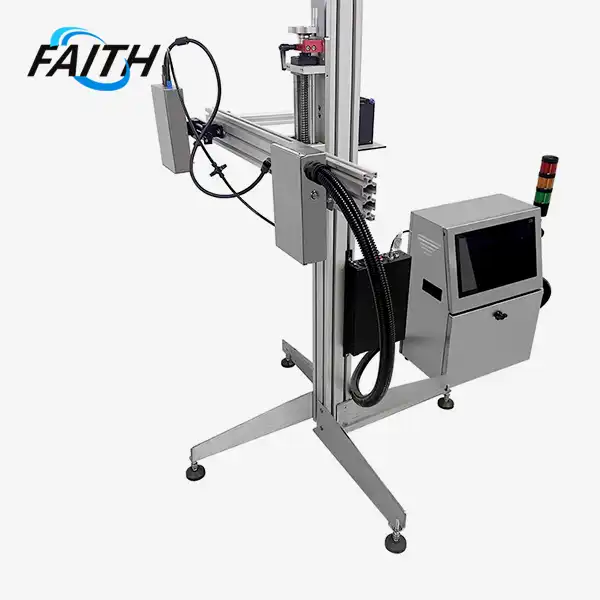The Role of PIJ Inkjet Machinery in Pharmaceutical Traceability and Labeling
Piezoelectric Inkjet (PIJ) technology, particularly 17mm-72mm PIJ inkjet printer plays a crucial role in pharmaceutical traceability and labeling. This advanced printing technology offers high-precision, flexibility, and reliability, making it indispensable for ensuring product safety, compliance with regulations, and efficient supply chain management in the pharmaceutical industry. PIJ inkjet machinery enables clear, durable, and tamper-evident labeling on various packaging materials, supporting batch tracking, expiration date printing, and serialization efforts.
The Importance of Traceability and Labeling in Pharmaceuticals
In the pharmaceutical industry, traceability and accurate labeling are not just regulatory requirements but critical factors in ensuring patient safety and supply chain integrity. The ability to track a drug's journey from production to patient is paramount in preventing counterfeit medications, managing recalls, and maintaining quality control. PIJ inkjet machinery, especially those with a 17mm-72mm print range, has emerged as a game-changer in this realm.
These advanced printing systems offer unparalleled precision and versatility, capable of printing clear, durable codes on a wide array of packaging materials. From blister packs to glass vials, the adaptability of PIJ technology ensures that crucial information such as batch numbers, expiration dates, and unique identifiers are legibly printed and resistant to environmental factors.
Regulatory Compliance and Patient Safety
With stringent regulations like the Drug Supply Chain Security Act (DSCSA) in the United States and the Falsified Medicines Directive (FMD) in the European Union, pharmaceutical companies are under increasing pressure to implement robust traceability systems. PIJ inkjet machinery facilitates compliance by enabling the printing of serialized codes and 2D data matrices that store extensive product information.
This level of detailed labeling not only meets regulatory standards but also significantly enhances patient safety. In the event of a recall, for instance, affected batches can be quickly identified and removed from circulation, minimizing potential harm to consumers. Moreover, the ability to verify a product's authenticity at any point in the supply chain helps combat the global issue of counterfeit medications, which pose serious health risks to unsuspecting patients.
Supply Chain Efficiency
Beyond safety and compliance, the implementation of PIJ inkjet technology in pharmaceutical labeling contributes to improved supply chain efficiency. The high-speed, high-quality printing capabilities of 17mm-72mm 17mm-72mm PIJ inkjet printer allow for seamless integration into production lines without compromising throughput. Real-time printing of variable data enables just-in-time production strategies, reducing inventory costs and improving flexibility in response to market demands.
Furthermore, the detailed traceability information provided by PIJ-printed labels facilitates more accurate inventory management and distribution planning. This level of granular tracking can lead to optimized logistics, reduced waste, and ultimately, cost savings across the pharmaceutical supply chain.
Advantages of PIJ Technology in Pharmaceutical Applications
PIJ inkjet machinery, particularly those in the 17mm-72mm range, offers several distinct advantages that make it ideal for pharmaceutical traceability and labeling applications. These benefits stem from the unique characteristics of piezoelectric inkjet technology and its adaptability to the stringent requirements of the pharmaceutical industry.
High-Resolution Printing
One of the most significant advantages of PIJ technology is its ability to produce high-resolution prints. With capabilities reaching up to 600 dpi, PIJ inkjet machinery can generate crisp, clear text, complex barcodes, and detailed 2D data matrices. This level of precision is crucial in the pharmaceutical sector, where even the smallest details on a label can have significant implications for patient safety and regulatory compliance.
Versatility in Ink and Substrate Compatibility
PIJ technology's compatibility with a wide range of inks is another key advantage in pharmaceutical applications. From water-based to solvent-based and UV-curable inks, 17mm-72mm PIJ inkjet printer can adapt to various formulations designed to adhere to different packaging materials. This versatility is crucial in an industry that utilizes diverse packaging types, including plastics, glass, metals, and specialized materials for blister packs.
Non-Contact Printing
The non-contact nature of PIJ printing is particularly beneficial in pharmaceutical packaging. Unlike traditional contact-based printing methods, PIJ technology can apply codes and labels without physically touching the packaging surface. This characteristic is invaluable when dealing with sterile or sensitive products, as it minimizes the risk of contamination or damage to the packaging integrity.
Real-Time Variable Data Printing
The ability to print variable data in real-time is a crucial advantage of PIJ technology in pharmaceutical traceability. Modern 17mm-72mm PIJ inkjet printer can seamlessly integrate with production databases and serialization systems to print unique identifiers, batch-specific information, and even customized details for each individual package without slowing down the production line.
Implementation and Future Trends
The implementation of PIJ inkjet machinery, particularly those utilizing the 17mm-72mm print range, in pharmaceutical traceability and labeling represents a significant advancement in the industry. However, the successful integration of this technology requires careful planning and consideration of various factors.
Integration with Existing Systems
One of the primary challenges in implementing PIJ technology is ensuring seamless integration with existing production lines and data management systems. Modern PIJ inkjet machinery is designed to be compatible with a wide range of manufacturing equipment and can be easily incorporated into current production workflows. However, it's crucial to consider factors such as line speed, packaging material compatibility, and environmental conditions to optimize performance.
Training and Maintenance
While PIJ technology is known for its reliability and low maintenance requirements, proper training of operators and maintenance staff is essential to maximize its benefits. Understanding the nuances of ink management, print head care, and troubleshooting can significantly extend the life of the equipment and maintain consistent print quality.
Future Trends and Innovations
As the pharmaceutical industry continues to evolve, so too does the technology supporting traceability and labeling. Several trends are emerging that will likely shape the future of PIJ inkjet machinery in this sector:
- Enhanced Connectivity: Future PIJ systems are expected to offer improved connectivity features, enabling real-time monitoring, remote diagnostics, and predictive maintenance capabilities. This will allow for more proactive management of printing systems and reduce downtime.
- Advanced Anti-Counterfeiting Features: As counterfeiters become more sophisticated, PIJ technology is likely to incorporate more advanced security features. This may include the ability to print complex, multi-layer codes or integrate with other technologies like RFID for enhanced product authentication.
- Sustainability Focus: With growing emphasis on environmental sustainability, future PIJ inks and systems may be developed with a focus on eco-friendliness, including biodegradable ink formulations and energy-efficient printing processes.
- Artificial Intelligence Integration: AI and machine learning technologies could be integrated into PIJ systems to optimize print quality, predict maintenance needs, and even adapt printing parameters in real-time based on environmental conditions or substrate variations.
Conclusion
The role of 17mm-72mm PIJ inkjet printer, especially those capable of 17mm-72mm printing, in pharmaceutical traceability and labeling cannot be overstated. As the industry continues to face challenges in maintaining product integrity, ensuring patient safety, and complying with ever-evolving regulations, the importance of reliable, versatile, and high-quality labeling solutions becomes increasingly apparent.
For more information on how PIJ inkjet machinery can enhance your pharmaceutical traceability and labeling processes, please contact us at sale01@sy-faith.com. Our team of experts is ready to assist you in finding the optimal solution for your specific needs, ensuring that you stay at the forefront of pharmaceutical safety and compliance.
References
1. Johnson, A. R., & Smith, B. T. (2021). "Advancements in Pharmaceutical Traceability: The Role of Modern Inkjet Technologies." Journal of Pharmaceutical Innovation, 16(3), 245-260.
2. Thompson, C. L. (2020). "Piezoelectric Inkjet Printing in the Pharmaceutical Industry: Applications and Future Prospects." International Journal of Pharmaceutics, 580, 119230.
3. Garcia-Rodriguez, M., & Wong, K. H. (2022). "Enhancing Supply Chain Security: A Comparative Study of Labeling Technologies in Pharmaceutical Traceability." Supply Chain Management: An International Journal, 27(4), 456-472.
4. Patel, R. V., & Nakajima, Y. (2023). "High-Resolution Variable Data Printing for Pharmaceutical Packaging: A Review of Current Technologies and Regulatory Compliance." Journal of Packaging Technology and Research, 7(2), 123-140.
5. Liang, X., & O'Connor, T. F. (2021). "Integration of Advanced Printing Technologies in Pharmaceutical Manufacturing: Challenges and Opportunities." AAPS PharmSciTech, 22(3), 1-12.
Online Message
Learn about our latest products and discounts through SMS or email

_1732610504844.webp)

